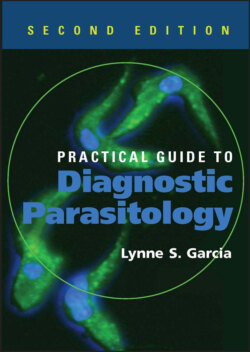Читать книгу Practical Guide to Diagnostic Parasitology - Lynne Shore Garcia - Страница 68
На сайте Литреса книга снята с продажи.
Pentastomids
ОглавлениеPentastomids are found in a separate phylum, Pentastomida, and are called tongue worms. Human infections have been reported from Africa, Europe, Asia, and the Americas. When humans serve as the intermediate hosts, the infective larvae die in situ. However, when mature larvae (often encysted) are ingested, they may migrate from the stomach, attach themselves to nasopharyngeal tissues, develop into adult pentastomids, and cause symptoms of the halzoun syndrome. Symptoms include throat discomfort, paroxysmal coughing, sneezing, and occasionally dysphagia and vomiting. Pentastomids isolated from humans include Armillifer spp., Linguatula serrata, and Sebekia spp.
Rare eye infections have been reported; inflammation is minimal, and the infection is probably the result of direct eye contact with water containing pentastomid eggs. Even more rare is human infection caused by a pentastomid larva belonging to the genus Sebekia. The adult worms are parasites found in the respiratory tract of reptiles, and the larval forms are found in the viscera, in the muscles, and along the spinal cord of freshwater fish. There may be serpiginous burrows surrounded by an intense erythematous zone and a 30% eosinophilia. The infection was possibly acquired by the ingestion of water containing eggs of the parasites or the ingestion of raw or improperly cooked fish.
Diagnosis is made by identifying the pentastomid in a biopsy specimen or at autopsy.
